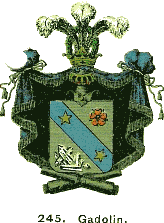

Johan Gadolin (1760-1852)
Finnish chemist who discovered Yttrium, in 1792.
The above is a copyrighted picture
reproduced here by permission. © 2008 by
Jochen Wilke.
Swedish blazon kindly provided by
Anders Segersven
from
Granfelts Vapenbok ("Finlands Ridderskaps och Adels Vapenbok", Helsinki/Helsingfors 1888).
Shield : Argent, a bend Azure charged with two mullets Or
between
a rose Gules in chief and a bunch of crystals
[of gadolinite?] Proper in base.
Crowned helmet ; three ostrich feathers Argent on a laurel wreath Vert.
Mantling : Azure, doubled Sable.
[ Two cannons in saltire under the shield. ]
Vapnet : En sköld af silfver fält med en blå balk,
belagd med två femuddiga gyllene stjärnor,
samt sidosatt, å vänster en chef med en röd ros å höger
med en stuff kristaller ("gadolinit"?).
Krönt hjälm ; tre hvita plymer ur en grön lagerkrans.
Hjälmtäcke blått, af svart foder.
[ Under skölden korsvis två kanoner. ]
The family of Johan Gadolin is registered under number
245
in the Finnish House of Nobility
(Riddarhuset).
It's distinct from a related (extinct)
Gadolin family which bore slightly different arms and was registered under number
180.
The chemist Johan Gadolin
(1760-1852) was born in Turku, Finland. His father,
Jakob Gadolin (1719-1802)
was Professor of Physics at the University of Turku (founded in 1640)
and would soon become Professor of Theology (1662) and finally, in 1788, Bishop of Turku
(Turku was the oldest diocese in Finland; it had become Lutheran at the time of the
Reformation).
Apparently, the paternal grandfather of Johan, also named Jakob,
was a Lutheran minister himself who had taken on the surname Gadolin
from the Hebrew word gadol ("great").
On the maternal side, the grandfather of Johan Gadolin was
Johan Browallius (1707-1755)
Professor of Botany at the University of Turku
and a good friend of Linnaeus (1707-1778).
He also served as Lutheran
Bishop of Turku
from 1749 to 1755
(about 40 years before his son-in-law would hold the same office).
In 1792, Johan Gadolin
analyzed samples of a mineral which had been discovered
by Lieutenant Arrhenius in 1788, next to the Swedish village of
Ytterby, near Stockholm
(that mineral would be named gadolinite
in 1800).
In it, Gadolin found a new substance which he called "ytterbia" at first, but
the name was shortened to yttria in 1797, by the deaf Swedish chemist
Anders Gustaf Ekeberg (1767-1813) as he repeated Gadolin's experiments at
Uppsala
(Ekeberg would later be credited with the discovery of tantalum (73)
in 1802).
Gadolin's yttria turns out to be (mostly) an oxide of the first
rare earth element ever discovered,
which we now call yttrium (Z=39, Symbol: Y).
Gadolin himself obtained yttrium trihydroxide shortly thereafter.
He published his discoveries about yttria in 1794.
At first, yttria
itself was thought to be an element, but it proved to be the
oxide of a new element, as shown by
Humphry Davy (1778-1829) in 1808...
Rare-earth elements are simply, by definition, the elements in the third
column of the Periodic Table
(4 "boxes" which span a total of 32 elements,
including the 15 lanthanides and the 15 radioactive actinides).
Almost half of the 68 transition metals
[below element 112] are rare earths.
Several rare-earth elements besides
yttrium (39) can be found in gadolinite. The lightest
of them is
scandium (Z=21) which was
discovered
in 1879 by the Swedish chemist
Lars Fredrik Nilson
(1840-1899) who extracted its oxide (scandia)
from both gadolinite and euxenite.
Nilson suspected that scandium was actually the hypothetical
ekaboron
predicted
in 1869 by Mendeleev...
This was confirmed shortly thereafter by the Swedish chemist
Per Theodor Cleve
(1840-1905) the father of
Astrid Cleve von Euler
(1875-1968) and
grandfather of Ulf von Euler (1905-1983;
Nobel 1970).
Gadolinium (64) is another
rare earth (a lanthanide) which can be found in some samples
of gadolinite, although extraction from
monazite or
bastnäsite seems commercially
more important nowadays.
Uniquely, this is a metal which is strongly
ferromagnetic (like iron)
in the Winter but looses its ferromagnetic properties in hot weather.
Indeed, its Curie temperature happens to be
very close to
room temoerature
(it's listed as
293.2 K, which is about 20°C or 68°F).
Gadolinium was discovered in its oxidized form (gadolinia)
in 1880 by the Swiss chemist
Jean Charles
Galissard de Marignac (1817-1894). The metal itself was isolated in 1885 by
Lecoq de Boisbaudran (1838-1912)
the prolific French chemist who discovered
gallium (31) in 1875,
samarium (62) in 1880,
and dysprosim (66) in 1886...
Both the gadolinium metal and its oxide (gadolinia)
were indirectly named after Johan Gadolin, simply because the key mineral (which Gadolin
had worked on in 1792) had been known as gadolinite since 1800.



